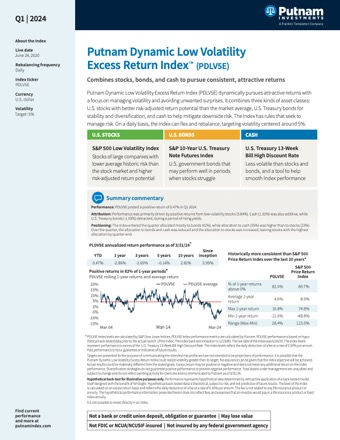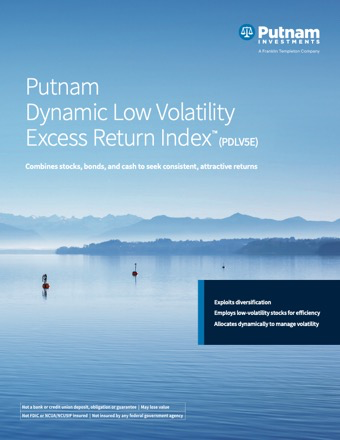Source: S&P Dow Jones Indices, LLC.
The Index is composed of the S&P 500 Low Volatility Index (Stocks), S&P 10-Year U.S. Treasury Note Futures Index (Bonds), and U.S. Treasury 13-Week Bill High Discount Rate (Cash). Allocations shown may not total 100% due to rounding.
The Index is rebalanced daily. Allocations shown are as of the last day of the month for each month listed. Historical asset allocations are hypothetical prior to 6/24/20 and live thereafter. Hypothetical allocations illustrate how the Putnam Dynamic Low Volatility Excess Return Index would have responded to market conditions from 8/31/19 through 6/24/20 had it existed. The information does not represent the current allocations of the Index. It is only provided as an example of how the allocations would have worked in certain market environments. Asset allocation strategies do not guarantee positive performance or prevent negative performance. Past performance is not a guarantee of future results.
Historical asset allocations prior to June 24, 2020, are hypothetical and illustrate how the Putnam Dynamic Low Volatility Excess Return Index would have responded to market conditions had it existed. The information does not represent the current allocations of the Index. It is only provided as an example of how the allocations would have worked in certain market environments. No future asset allocations of the Index can be predicted based on the simulated asset allocations described herein. The live date of the Index was June 24, 2020. Asset allocation strategies do not guarantee positive performance or prevent negative performance.
PDLV5E annualized return performance is as of most recent month-end period.
The Putnam Dynamic Low Volatility Excess Return Index (PDLV5E) performance is based on hypothetical back-tested data prior to the actual launch of the Index: The Index back-test inception is December 29, 1989. The live date of the Index was June 24, 2020. The hypothetical back-testing period is December 29, 1989–June 24, 2020. Returns are shown in U.S. dollars. Past performance is not a guarantee of future results.
Hypothetical back-test for illustrative purposes only. Prior to June 24, 2020, performance represents hypothetical data determined by retroactive application of a back-tested model, itself designed with the benefit of hindsight. Hypothetical back-tested data is theoretical, subject to risk, and not predictive of future results. The Index levels reflect the daily deduction of a fee at a rate of 0.5% per annum. The fee is not related to any annuity. The hypothetical performance information presented herein does not reflect fees and expenses that an investor would pay in a fixed index annuity.
It is not possible to invest directly in an index.






